Microstructure and Mechanical Properties of Co-Sputtering (Mo, Hf)N Coatings
Abstract
:1. Introduction
2. Experimental Details
3. Results and Discussion
3.1. Composition Analyses
3.2. Microstructure Analysis
3.3. Identification of Nanostructure
3.4. Mechanical Behavior
3.4.1. Indentation Hardness and Elastic Modulus
3.4.2. Wear Characteristic
4. Conclusions
Author Contributions
Funding
Institutional Review Board Statement
Informed Consent Statement
Data Availability Statement
Conflicts of Interest
References
- Lévy, F.; Hones, P.; Schmid, P.E.; Sanjinés, R.; Diserens, M.; Wiemer, C. Electronic states and mechanical properties in transition metal nitrides. Surf. Coat. Technol. 1999, 120–121, 284–290. [Google Scholar] [CrossRef]
- Mei, Z.G.; Bhattacharya, S.; Yacout, A.M. First-principles study of fracture toughness enhancement in transition metal nitrides. Surf. Coat. Technol. 2019, 357, 903–909. [Google Scholar] [CrossRef]
- He, C.; Zhang, J.; Wang, J.; Ma, G.; Zhao, D.; Cai, Q. Effect of structural defects on corrosion initiation of TiN nanocrystalline films. Appl. Surf. Sci. 2013, 276, 667–671. [Google Scholar] [CrossRef]
- Lin, J.; Sproul, W.D.; Moore, J.J. Tribological behavior of thick CrN coatings deposited by modulated pulsed power magnetron sputtering. Surf. Coat. Technol. 2012, 206, 2474–2483. [Google Scholar] [CrossRef]
- Zhu, F.; Zhu, K.; Hu, Y.; Ling, Y.; Wang, D.; Peng, H.; Xie, Z.; Yang, R.; Zhang, Z. Microstructure and Young’s modulus of ZrN thin film prepared by dual ion beam sputtering deposition. Surf. Coat. Technol. 2019, 374, 997–1005. [Google Scholar] [CrossRef]
- Fenker, M.; Balzer, M.; Büchi, R.V.; Jehn, H.A.; Kappl, H.; Lee, J.J. Deposition of NbN thin films onto high-speed steel using reactive magnetron sputtering for corrosion protective applications. Surf. Coat. Technol. 2003, 163–164, 169–175. [Google Scholar] [CrossRef]
- Xiang, J.Y.; Wu, F.B. Gas inlet and input power modulated sputtering molybdenum nitride thin films. Surf. Coat. Technol. 2017, 332, 161–167. [Google Scholar] [CrossRef]
- Ke, Y.E.; Chen, Y.I. Mechanical properties, bonding characteristics, and thermal stability of magnetron-sputtered HfNx films. Surf. Coat. Technol. 2020, 388, 125575. [Google Scholar] [CrossRef]
- Riekkinen, T.; Molarius, J.; Laurila, T.; Nurmela, A.; Suni, I.; Kivilahti, J.K. Reactive sputter deposition and properties of TaxN thin films. Microelectron. Eng. 2002, 64, 289–297. [Google Scholar] [CrossRef]
- Li, H.; Li, J.; Liu, Z.; Huang, J.; Kong, J.; Xiong, D. Mechanical and tribological properties of Hf1−xMoxNy thin films as a function of Mo contents. Surf. Coat. Technol. 2019, 375, 589–599. [Google Scholar] [CrossRef]
- Yao, S.H.; Su, Y.L.; Kao, W.H.; Cheng, K.W. Evaluation on wear behavior of Cr–Ag–N and Cr–W–N PVD nanocomposite coatings using two different types of tribometer. Surf. Coat. Technol. 2006, 201, 2520–2526. [Google Scholar] [CrossRef]
- Zeman, P.; Čerstvý, R.; Mayrhofer, P.H.; Mitterer, C.; Musil, J. Structure and properties of hard and superhard Zr–Cu–N nanocomposite coatings. Mater. Sci. Eng. A 2000, 289, 189–197. [Google Scholar] [CrossRef]
- Ezirmik, K.V.; Rouhi, S. Influence of Cu additions on the mechanical and wear properties of NbN coatings. Surf. Coat. Technol. 2014, 260, 179–185. [Google Scholar] [CrossRef]
- Kim, S.; Yoon, H.W.; Moon, K.I.; Lee, C.S. Mechanical and friction behavior of sputtered Mo–Cu–(N) coatings under various N2 gas flow using a multicomponent single alloy target. Surf. Coat. Technol. 2021, 412, 127060. [Google Scholar] [CrossRef]
- Hahn, R.; Tymoszuk, A.; Wojcik, T.; Kirnbauer, A.; Kozák, T.; Čapek, J.; Sauer, M.; Foelske, A.; Hunold, O.; Polcik, P.; et al. Phase formation and mechanical properties of reactively and non-reactively sputtered Ti-B-N hard coatings. Surf. Coat. Technol. 2021, 420, 127327. [Google Scholar] [CrossRef]
- Wo, P.C.; Munroe, P.R.; Li, Z.; Jiang, Z.T.; Xie, Z.H.; Zhou, Z.F.; Li, K.Y. Factors governing the mechanical behaviour of CrSiN coatings: Combined nanoindentation testing and transmission electron microscopy. Mater. Sci. Eng. A 2012, 534, 297–308. [Google Scholar] [CrossRef] [Green Version]
- Diyatmika, W.; Cheng, C.Y.; Lee, J.W. Fabrication of Cr-Si-N coatings using a hybrid high-power impulse and radio-frequency magnetron co-sputtering: The role of Si incorporation and duty cycle. Surf. Coat. Technol. 2020, 403, 126378. [Google Scholar] [CrossRef]
- Mae, T.; Nose, M.; Zhou, M.; Nagae, T.; Shimamura, K. The effects of Si addition on the structure and mechanical properties of ZrN thin films deposited by an r.f. reactive sputtering method. Surf. Coat. Technol. 2001, 142–144, 954–958. [Google Scholar] [CrossRef]
- Oliveira, J.C.; Manaia, A.; Cavaleiro, A.; Vieira, M.T. Structure, hardness and thermal stability of Ti(Al,N) coatings. Surf. Coat. Technol. 2006, 201, 4073–4077. [Google Scholar] [CrossRef] [Green Version]
- Wang, T.; Zhang, G.; Liu, Z.; Jiang, B. Oxidation behavior of magnetron sputtered Mo2N/AlN multilayer coatings during heat treatment. Ceram. Int. 2015, 41, 7028–7035. [Google Scholar] [CrossRef]
- Tillmann, W.; Kokalj, D.; Stangier, D. Influence of the deposition parameters on the texture and mechanical properties of magnetron sputtered cubic MoNx thin films. Materialia 2019, 5, 100186. [Google Scholar] [CrossRef]
- Li, H.; Liu, Z.; Li, J.; Huang, J.; Kong, J.; Wu, Q.; Xiong, D. Effects of Hf addition on the structure, mechanical and tribological properties of CrN film. Surf. Coat. Technol. 2020, 397, 126067. [Google Scholar] [CrossRef]
- Zhang, D.; Qi, Z.; Wei, B.; Shen, H.; Wang, Z. Microstructure and corrosion behaviors of conductive Hf/HfN multilayer coatings on magnesium alloys. Ceram. Int. 2018, 44, 9958–9966. [Google Scholar] [CrossRef]
- Hart, G.; Klein, B.M. Phonon and elastic instabilities in MoC and MoN. Phys. Rev. B 2000, 61, 3151–3154. [Google Scholar] [CrossRef] [Green Version]
- Koutná, N.; Holec, D.; Friák, M.; Mayrhofer, P.H.; Šob, M. Stability and elasticity of metastable solid solutions and superlattices in the MoN–TaN system: First-principles calculations. Mater. Des. 2018, 144, 310–322. [Google Scholar] [CrossRef]
- Gu, Z.; Hu, C.; Huang, H.; Zhang, S.; Fan, X.; Wang, X.; Zheng, W. Identification and thermodynamic mechanism of the phase transition in hafnium nitride films. Acta Mater. 2015, 90, 59–68. [Google Scholar] [CrossRef]
- Mayrhofer, P.H.; Rachbauer, R.; Holec, D.; Rovere, F.; Schneider, J.M. Protective Transition Metal Nitride Coatings. In Comprehensive Materials Processing; Hashmi, S., Batalha, G.F., Tyne, C.V., Yilbas, B., Eds.; Elsevier: Amsterdam, The Netherlands, 2014; Chapter 4.14; pp. 355–388. [Google Scholar]
- Wu, F.B.; Chen, Y.I.; Lee, J.W.; Duh, J.G. Multilayer Transition Metal Nitride Protective Coatings. In Protective Thin Coatings Technology; Zhang, S., Ting, J.M., Wu, W.Y., Eds.; CRC Press: Boca Raton, FL, USA, 2022; Chapter 3; pp. 95–139. [Google Scholar]
- Kimura, A.; Hasegawa, H.; Yamada, K.; Suzuki, T. Effects of Al content on hardness, lattice parameter and microstructure of Ti1−xAlxN films. Surf. Coat. Technol. 1999, 120–121, 438–441. [Google Scholar] [CrossRef]
- Pacher, F.; Mayrhofer, P.H.; Holec, D. Vacancy-driven extended stability of cubic metastable Ta-Al-N and Nb-Al-N phases. Surf. Coat. Technol. A 2017, 326, 37–44. [Google Scholar] [CrossRef] [Green Version]
- Han, J.G.; Myung, H.S.; Lee, H.M.; Shaginyan, L.R. Microstructure and mechanical properties of Ti–Ag–N and Ti–Cr–N superhard nanostructured coatings. Surf. Coat. Technol. 2003, 174–175, 738–743. [Google Scholar] [CrossRef]
- Tsai, D.C.; Chang, Z.C.; Kuo, L.Y.; Lin, T.J.; Lin, T.N.; Shieu, F.S. Solid solution coating of (TiVCrZrHf)N with unusual structural evolution. Surf. Coat. Technol. 2013, 217, 84–87. [Google Scholar] [CrossRef]
- Roberson, S.L.; Finello, D.; Davis, R.F. Growth of MoxN films via chemical vapor deposition of MoCl5 and NH3. Surf. Coat. Technol. 1998, 102, 256–259. [Google Scholar] [CrossRef]
- Qian, J.; Li, S.; Pu, J.; Cai, Z.; Wang, H.; Cai, Q.; Ju, P. Effect of heat treatment on structure and properties of molybdenum nitride and molybdenum carbonitride films prepared by magnetron sputtering. Surf. Coat. Technol. 2019, 374, 725–735. [Google Scholar] [CrossRef]
- Krysina, O.V.; Ivanov, Y.F.; Koval, N.N.; Prokopenko, N.A.; Shugurov, V.V.; Petrikova, E.A.; Tolkachev, O.S. Composition, structure and properties of Mo-N coatings formed by the method of vacuum-arc plasma-assisted deposition. Surf. Coat. Technol. 2021, 416, 127153. [Google Scholar] [CrossRef]
- Mikula, M.; Uzon, S.; Hudec, T.; Grančič, B.; Truchlý, M.; Roch, T.; Švec, P.; Satrapinskyy, L.; Čaplovičová, M.; Greczynski, G.; et al. Thermally induced structural evolution and age-hardening of polycrystalline V1−xMoxN (x ≈ 0.4) thin films. Surf. Coat. Technol. 2021, 405, 126723. [Google Scholar] [CrossRef]
- Zhao, X.; Li, H.; Li, J.; Hu, J.; Huang, J.; Kong, J.; Wu, Q.; Shi, Y.; Xiong, D. Mechanical and tribological behaviors of hard and tough TaxHf1−xN films with various Ta contents. Surf. Coat. Technol. 2020, 403, 126412. [Google Scholar] [CrossRef]
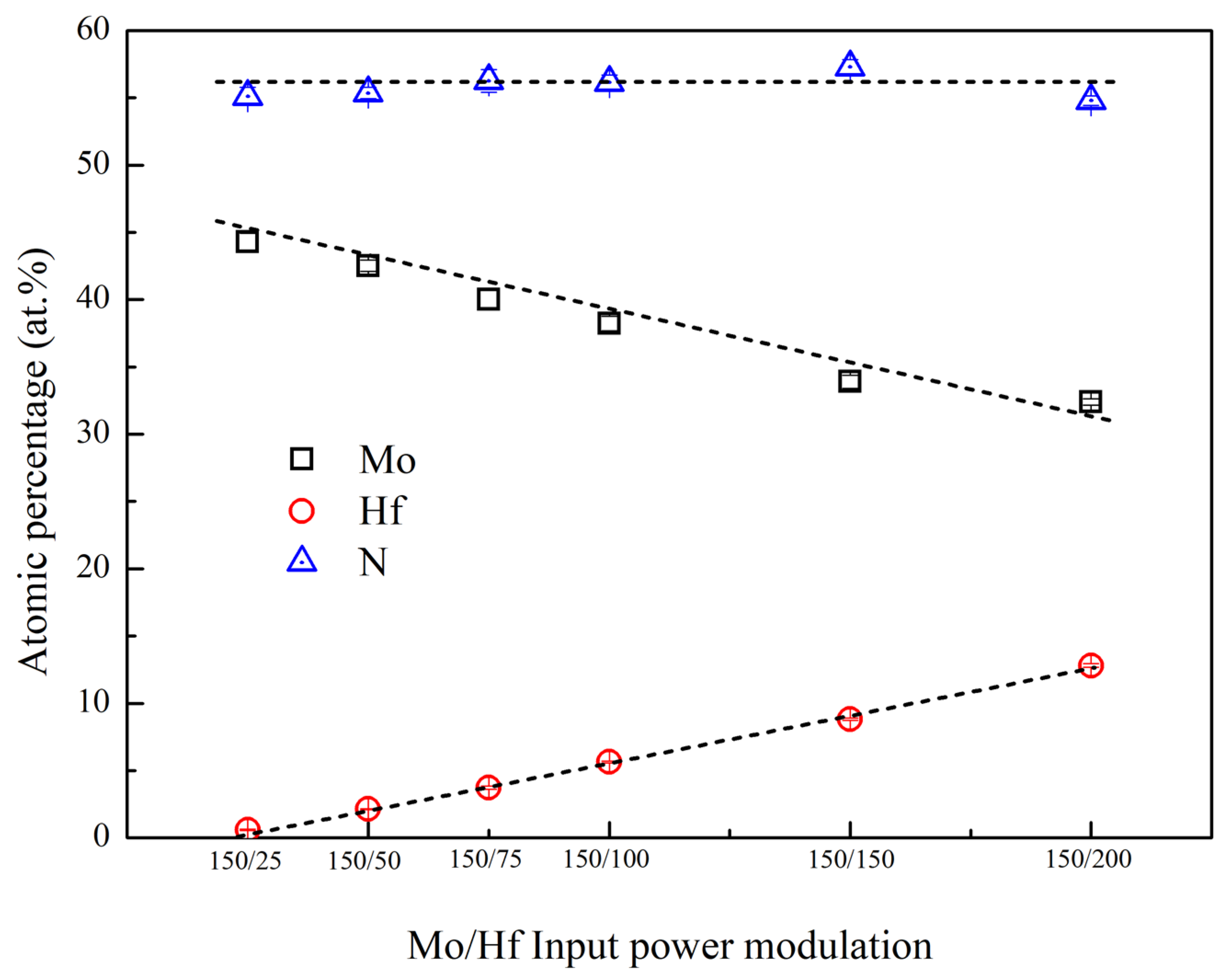
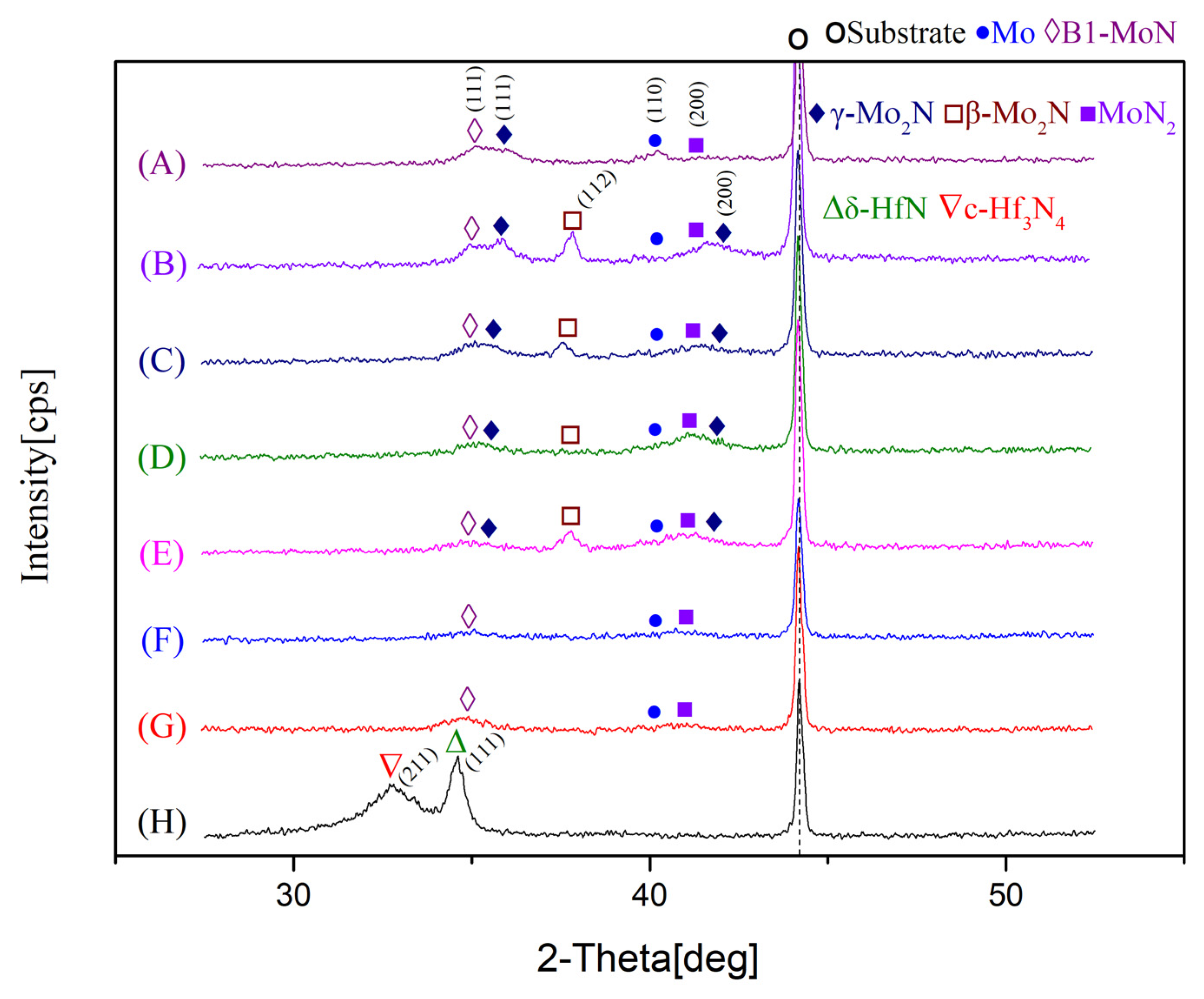
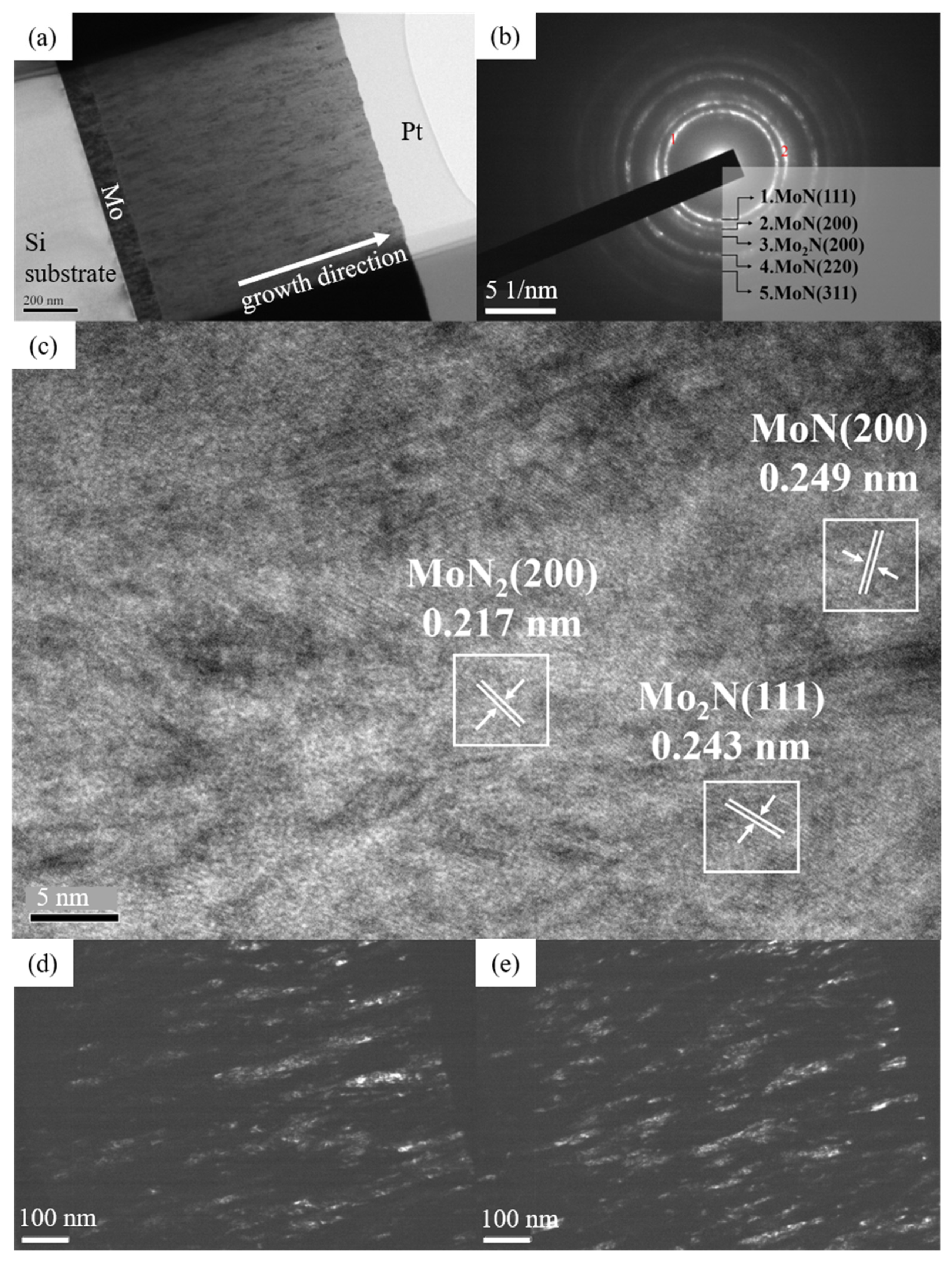
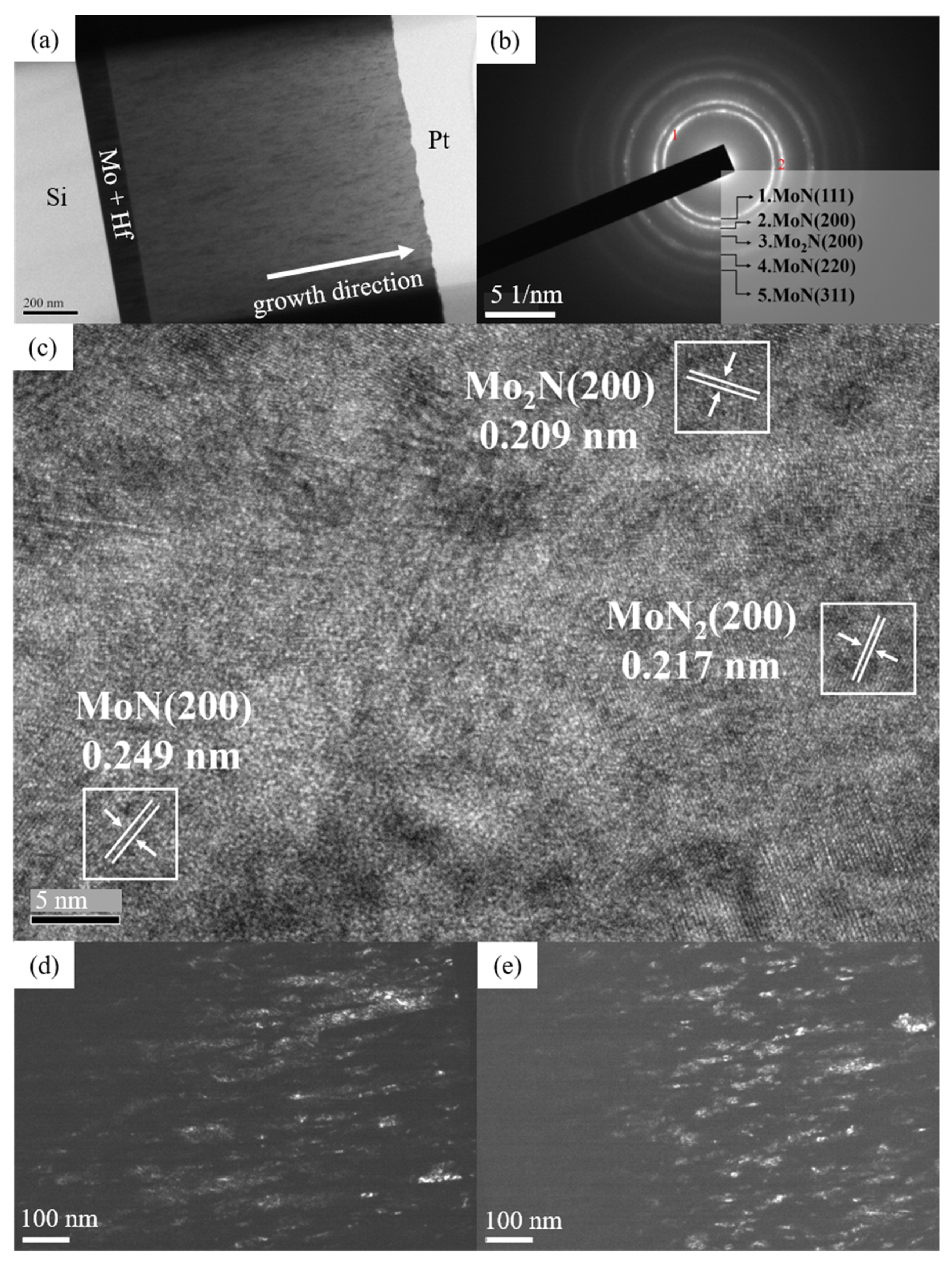


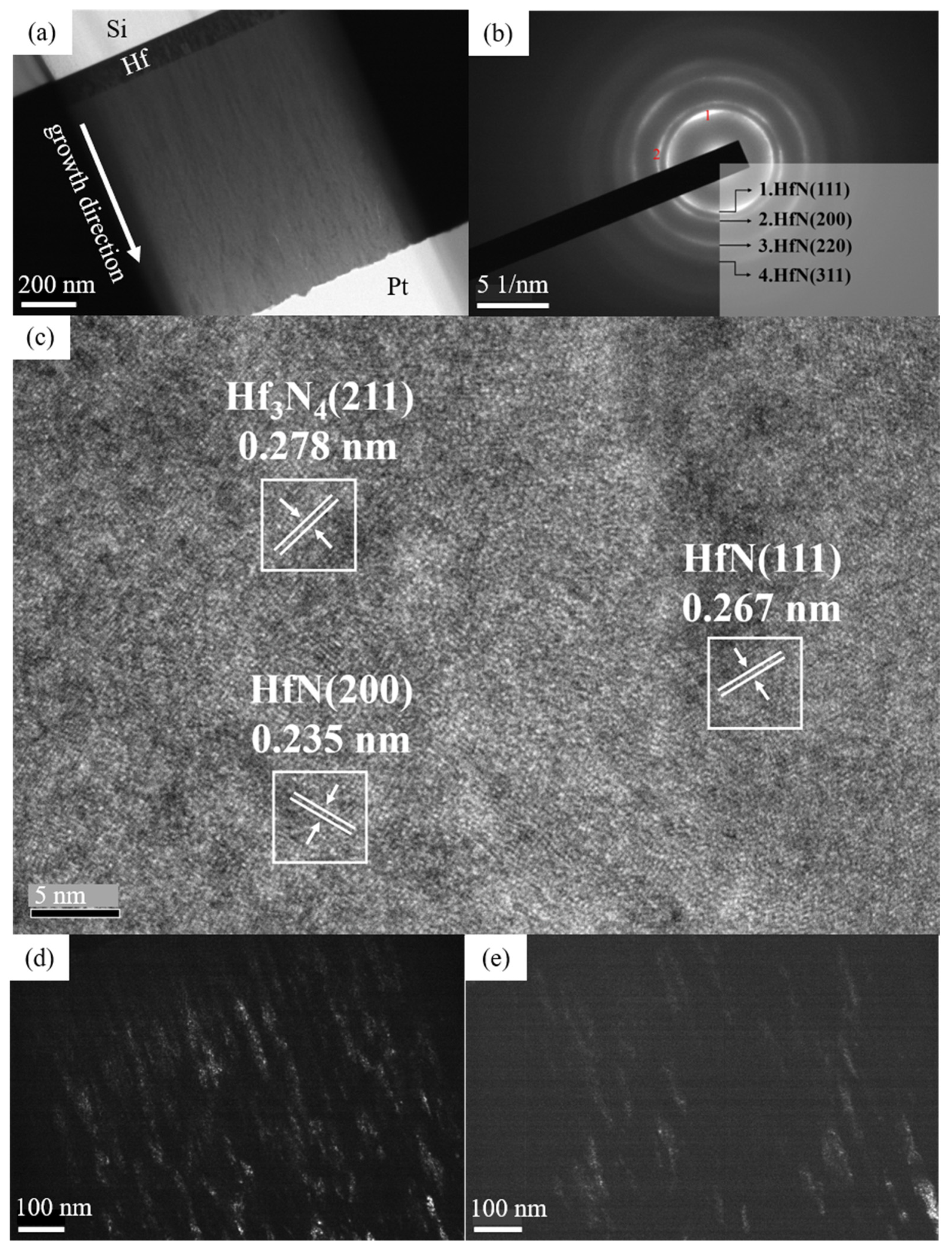

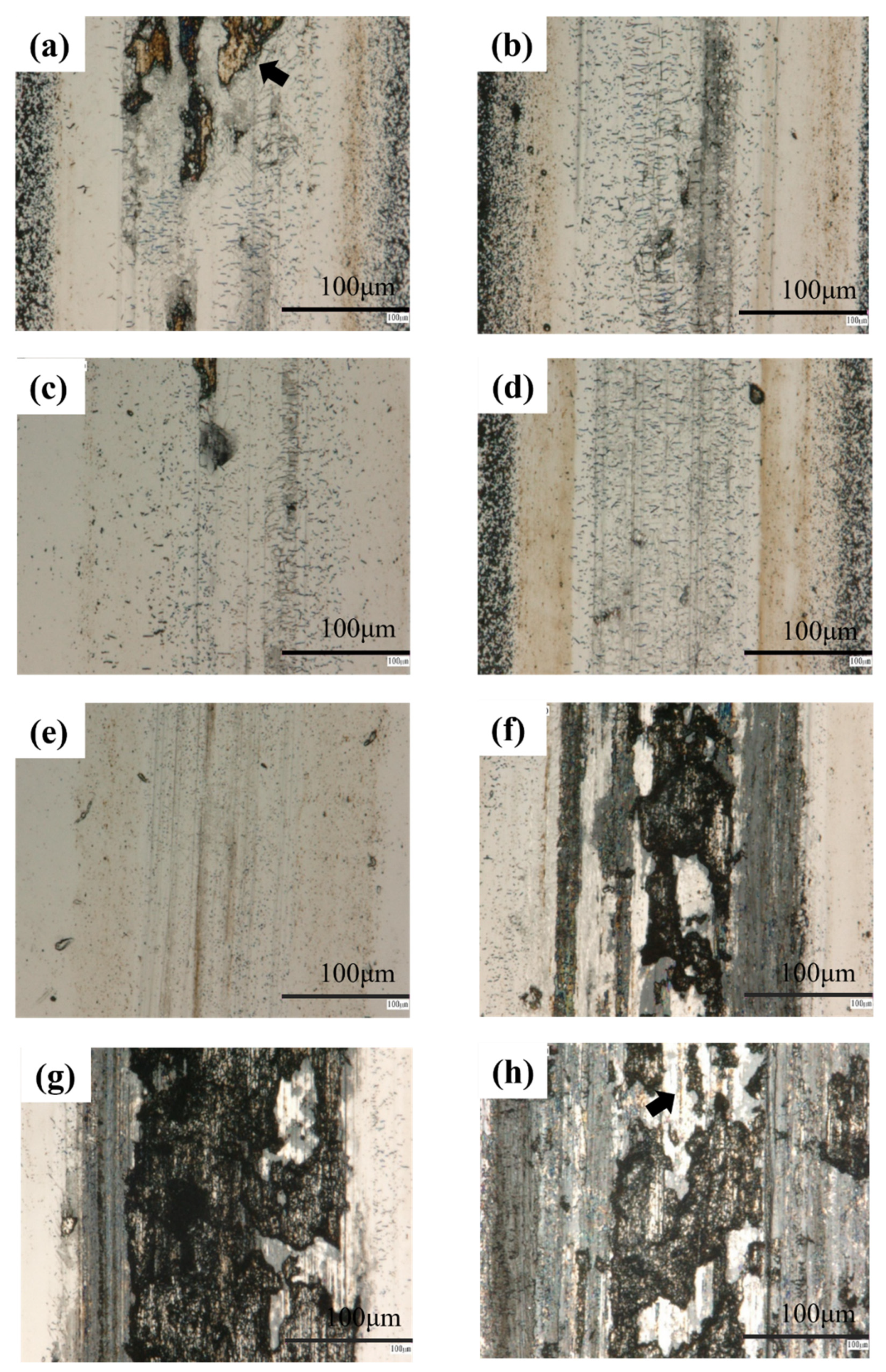
| Sample Name | Gas Inlet Ar/N2 (Sccm/Sccm) | Input Power (W) | Composition (at.%) | Mo/Hf | (Mo + Hf)/N | Deposition Rate (nm/min) | |||
|---|---|---|---|---|---|---|---|---|---|
| Mo | Hf | Mo | Hf | N | |||||
| A | 12/8 | 150 | 0 | 45.9 ± 0.4 | 0 | 54.1 ± 0.4 | - | 0.85 ± 0.02 | 7.4 |
| B | 150 | 25 | 44.3 ± 0.6 | 0.6 ± 0.0 | 55.1 ± 0.7 | 73.8 | 0.82 ± 0.08 | 6.0 | |
| C | 150 | 50 | 42.5 ± 0.4 | 2.1 ± 0.0 | 55.4 ± 0.4 | 20.2 | 0.80 ± 0.02 | 6.7 | |
| D | 150 | 75 | 40.0 ± 0.7 | 3.7 ± 0.1 | 56.3 ± 0.9 | 10.8 | 0.78 ± 0.03 | 7.0 | |
| E | 150 | 100 | 38.2 ± 0.5 | 5.6 ± 0.1 | 56.1 ± 0.5 | 6.8 | 0.78 ± 0.02 | 8.2 | |
| F | 150 | 150 | 33.9 ± 0.5 | 8.8 ± 0.1 | 57.3 ± 0.5 | 3.9 | 0.75 ± 0.02 | 9.5 | |
| G | 150 | 200 | 32.4 ± 0.2 | 12.8 ± 0.1 | 54.8 ± 0.4 | 2.5 | 0.82 ± 0.02 | 9.7 | |
| H | 0 | 150 | 0 | 41.9 ± 0.8 | 58.1 ± 0.8 | - | 0.72 ± 0.03 | 2.1 | |
Publisher’s Note: MDPI stays neutral with regard to jurisdictional claims in published maps and institutional affiliations. |
© 2022 by the authors. Licensee MDPI, Basel, Switzerland. This article is an open access article distributed under the terms and conditions of the Creative Commons Attribution (CC BY) license (https://creativecommons.org/licenses/by/4.0/).
Share and Cite
Hsu, S.-Y.; Wu, F.-B. Microstructure and Mechanical Properties of Co-Sputtering (Mo, Hf)N Coatings. Coatings 2022, 12, 509. https://doi.org/10.3390/coatings12040509
Hsu S-Y, Wu F-B. Microstructure and Mechanical Properties of Co-Sputtering (Mo, Hf)N Coatings. Coatings. 2022; 12(4):509. https://doi.org/10.3390/coatings12040509
Chicago/Turabian StyleHsu, Shu-Yu, and Fan-Bean Wu. 2022. "Microstructure and Mechanical Properties of Co-Sputtering (Mo, Hf)N Coatings" Coatings 12, no. 4: 509. https://doi.org/10.3390/coatings12040509
APA StyleHsu, S.-Y., & Wu, F.-B. (2022). Microstructure and Mechanical Properties of Co-Sputtering (Mo, Hf)N Coatings. Coatings, 12(4), 509. https://doi.org/10.3390/coatings12040509





